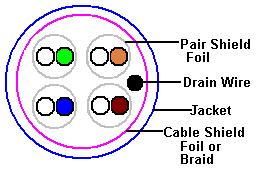Shielded Twisted Pair (STP) comes in a variety of formats. It is typically used in three applications:
Where there is significant EMI in the environment such as caused by high-powered electric motors (elevator shafts), flourescent lighting etc. Additionally where there is significant Alien Crosstalk (ANEXT) such as in very high speed (gigabit and 10gb) LANs. In this case the ethernet signals in the cable are protected against external interference from either adjacent pairs or the environment.
Where there is extremely sensitive electrical/electronic equipment in the surrounding environment or where security requirements demand elimination of eavesdropping possibilities from radiated LAN signals (TEMPEST). In this case the ethernet signals in the cable are contained and prevented from polluting, or escaping into, the external environment.
Where maximum performance - either speed or distance - is required. As Ethernet speeds continue to increase either fiber or Shielded Twisted Pair is becoming increasingly common, for instance, to reach 100m distances at 10Gb speeds on copper will require shielded cable (limited to 55m for UTP).
Shielded cable comes in three broad types with a confusing range of terminology:
Where there is a single foil (FTP - Foil Twisted Pair) or braided (ScTP - Screened Twisted Pair) shield inside the jacket covering all four pairs.
Where there is a foil shield covering each pair. This is frequently refered to as PiMF (Pairs in Metal Foil) and is designed primarily to eliminate Alien Cross-talk (ANEXT) from adjacent pairs.
Where there is a foil shield covering each pair and a (Foil or Braided) shield covering the whaoe cable. This is frequently refered to as SSTP (Double Shield Twisted Pair) or even PiMF - since many manufacturers also add a jacket shield to foil covered pair cables.
In almost all cases there is a single ground wire (called a drain) which allows for connection to secondary grounding sources.
The diagram below illustrates the differences:

Notes:
Shielded cable of any variety has a greater diameter than UTP and will therefore occupy more space in cable ducting and raceways.
Connecting shielded cable is more complex and time consuming - but not execessively so - than conventional UTP. Manufacturers specifications vary enormously, expecially with respect to grounding, and should be followed closely.
In shielded cable installations the jacks and receptacles are typically made of metal and the cable shield (foil or braid) is connected electrically to the connector and thence through the receptable to a suitable ground.
Foil covered pairs are typically not connected to ground and thus provide only alien crosstalk immunity from adjacent pairs.
Manufacturers specifications and measurements suggest that shielded cables do NOT create antenna effects - indeed experiments show that UTP creates a substantially greater antenna effect (~40db) over correctly grounded shielded cables.
Even ungrounded shielded cables provide better performance (by ~20db) than conventional unshielded twisted pair (UTP).
The drain wire provides a secondary or auxiliary ground method where metallic path grounding is provided by the connectors and, as such, is optional. In cases where metal connectors are not being used the drain wire may be used as the primary grounding method and needs to be routed independantly to a suitable ground.
No comments:
Post a Comment